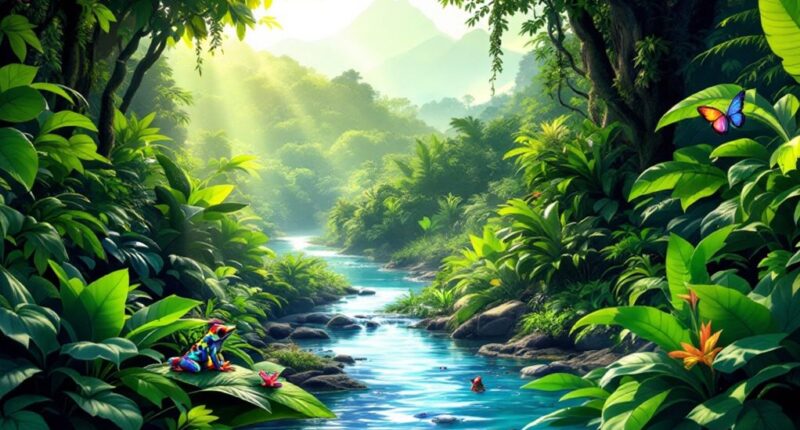Biodiversity conservation employs multiple strategies to protect Earth’s intricate web of life. Protected areas serve as nature’s lifeboats while restoration efforts revive degraded habitats. Wildlife corridors connect these protected patches, enabling animals to roam freely. Sustainable resource management guarantees we’re living off nature’s interest, not its capital. Meanwhile, endangered species receive intensive care through captive breeding and anti-poaching measures. Community involvement and climate adaptation round out this thorough approach to safeguarding our planet’s biological richness.

The delicate web of life on Earth faces unprecedented threats, requiring extensive strategies to safeguard the planet’s biological diversity for future generations. As habitats shrink and species vanish at alarming rates, conservation biologists have developed a multilayered approach that works across ecosystems, communities, and political boundaries—like a chess master playing on several boards simultaneously.
Protected areas form the backbone of biodiversity conservation, creating sanctuaries where nature can thrive without human interference. These ecological lifeboats are being complemented by ambitious restoration efforts, turning degraded lands back into functioning ecosystems. Wildlife corridors—nature’s highways—connect these protected patches, allowing animals to travel, mate, and maintain genetic diversity without becoming roadkill on the highway of extinction. Maintaining species richness within these corridors helps sustain the resilience needed for ecosystems to adapt to changing conditions.
Nature’s sanctuary system—protected areas, restored landscapes, and wildlife highways—forms our planet’s ecological safety net against extinction.
Sustainable resource management approaches recognize that humans need to use natural resources but can do so without emptying nature’s bank account. From forest certification programs to ecosystem-based fisheries management, these practices aim to harvest today while ensuring there’s something left for tomorrow’s harvest—think of it as living off nature’s interest rather than depleting its capital.
For species teetering on the brink, targeted conservation programs provide intensive care. Captive breeding serves as a genetic insurance policy, while anti-poaching measures combat wildlife crime. Effective management of invasive species prevents the disruption of native ecosystems and protects vulnerable indigenous populations. These efforts are fundamentally running a biodiversity ICU for critical patients.
Climate change adds a whole new dimension to conservation challenges. Scientists are identifying climate refugia—natural bunkers where species might weather the storm of global warming—while also implementing assisted migration for species that need a lift to suitable habitats. The preservation of healthy ecosystems ensures the continued provision of essential services like clean air, water purification, and fertile soil that humans depend on for survival.
Local communities have emerged as conservation MVPs, with indigenous knowledge often providing solutions that Western science missed. When conservation creates economic benefits through ecotourism or payment for ecosystem services, protecting nature becomes less charity and more good business.
Behind these field efforts stands a framework of laws, policies, and international agreements that provide the rulebook for protecting our planet’s biological inheritance—ensuring that the symphony of life continues to play for generations to come.
Frequently Asked Questions
How Do Indigenous Knowledge Systems Enhance Biodiversity Conservation Practices?
Indigenous knowledge systems enhance biodiversity conservation through time-tested practices developed over generations.
These systems offer holistic approaches to ecosystem management, including sustainable harvesting methods and traditional burning techniques that promote biodiversity.
Indigenous-managed lands consistently show lower deforestation rates and equal or higher biodiversity compared to conventional protected areas.
The integration of Traditional Ecological Knowledge with modern conservation creates powerful partnerships that benefit both local communities and ecosystems while maintaining cultural connections to the land.
What Career Opportunities Exist in Biodiversity Conservation?
Biodiversity conservation offers diverse career paths across several sectors. Professionals can work as field researchers studying ecological processes, policy specialists developing conservation frameworks, or wildlife biologists protecting endangered species.
Opportunities exist in government agencies, non-profits, research institutions, and education centers. Positions range from hands-on fieldwork to policy development and public education.
Most roles require specialized education in biology, ecology, environmental science, or related fields, with advanced degrees often preferred for research positions.
How Can Individuals Contribute to Local Conservation Efforts?
Individuals can make meaningful contributions to local conservation through several practical actions. They can volunteer with local organizations, create wildlife-friendly spaces by planting native species, adopt sustainable consumption habits, and engage in community initiatives like habitat restoration projects.
Even small efforts—reducing pesticide use, installing bird feeders, or participating in citizen science programs—collectively create significant impact. By educating others and advocating for conservation causes, individuals become powerful catalysts for environmental protection in their communities.
How Does Climate Change Specifically Threaten Biodiversity Hotspots?
Climate change severely threatens biodiversity hotspots through accelerated temperature increases that outpace global averages.
These ecological treasure troves face disrupted precipitation patterns, extreme weather events, and shifting seasonality that alter critical habitat conditions.
Rising sea levels and ocean acidification devastate coastal and marine hotspots, while endemic species—already confined to specific regions—have limited migration options.
With 44% of hotspot species at high extinction risk, these irreplaceable ecosystems stand at the frontlines of climate change‘s devastating impacts.
What Economic Benefits Come From Biodiversity Conservation Projects?
Biodiversity conservation delivers substantial economic returns. Projects generate jobs—potentially 20-32 million by 2030—while protecting industries representing $44 trillion of global GDP.
The math is compelling: forests filter water for free, ecosystems buffer against disasters, and conservation sites attract tourism dollars.
Beyond balance sheets, these efforts open new markets for sustainable products and reduce healthcare costs by limiting disease transmission.
Nature’s services, valued at $150 trillion annually, represent the ultimate blue-chip investment.









